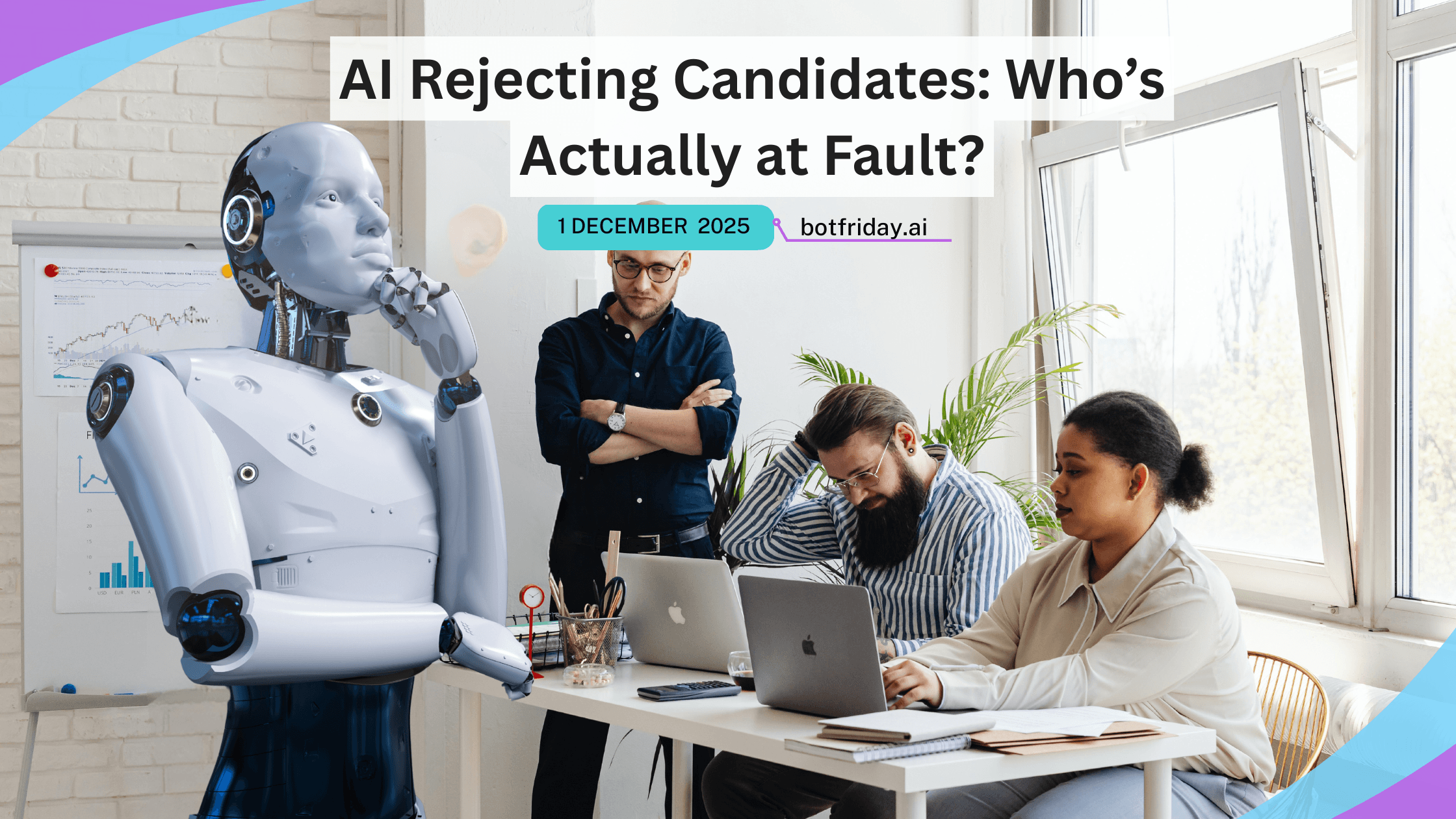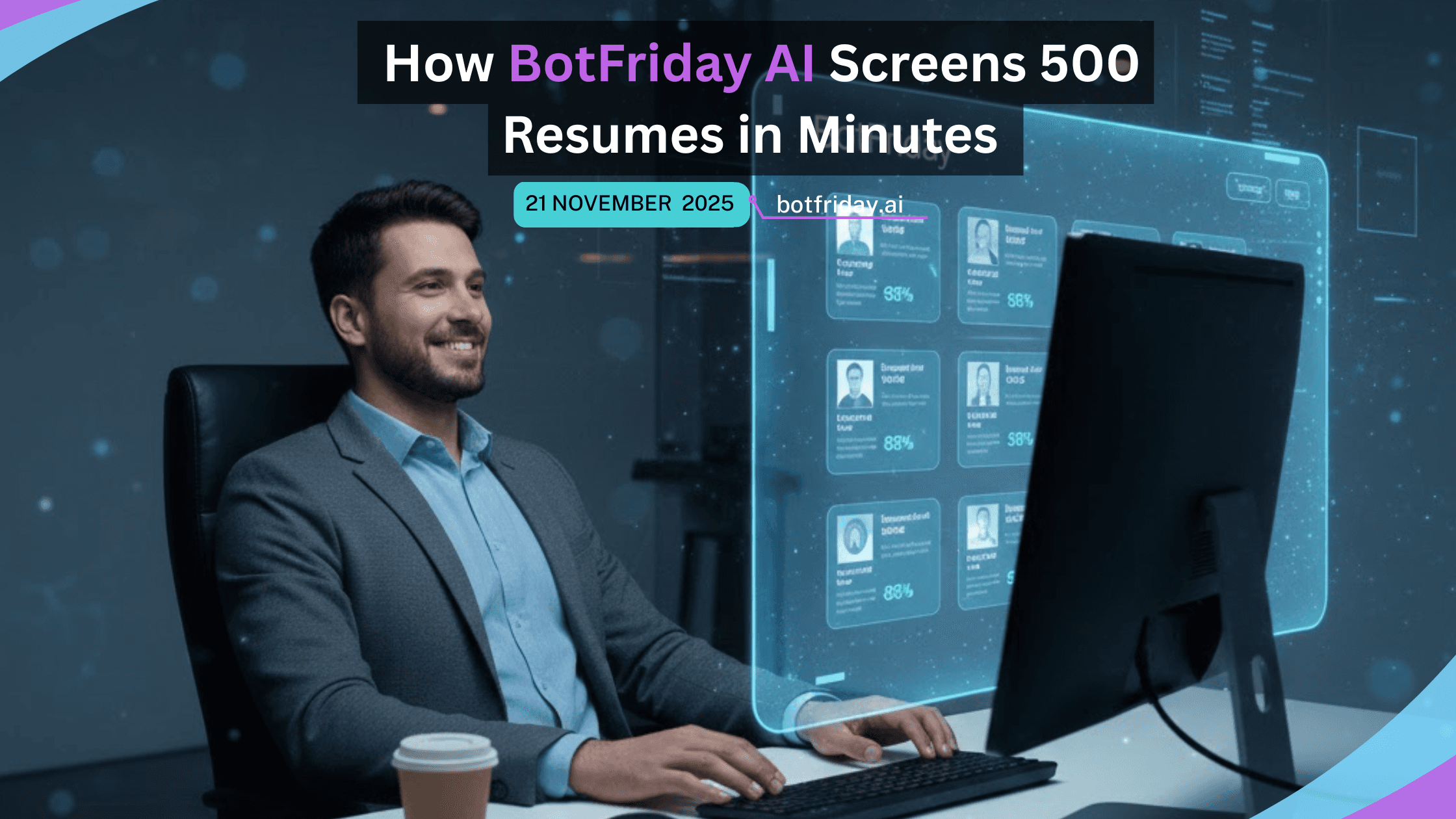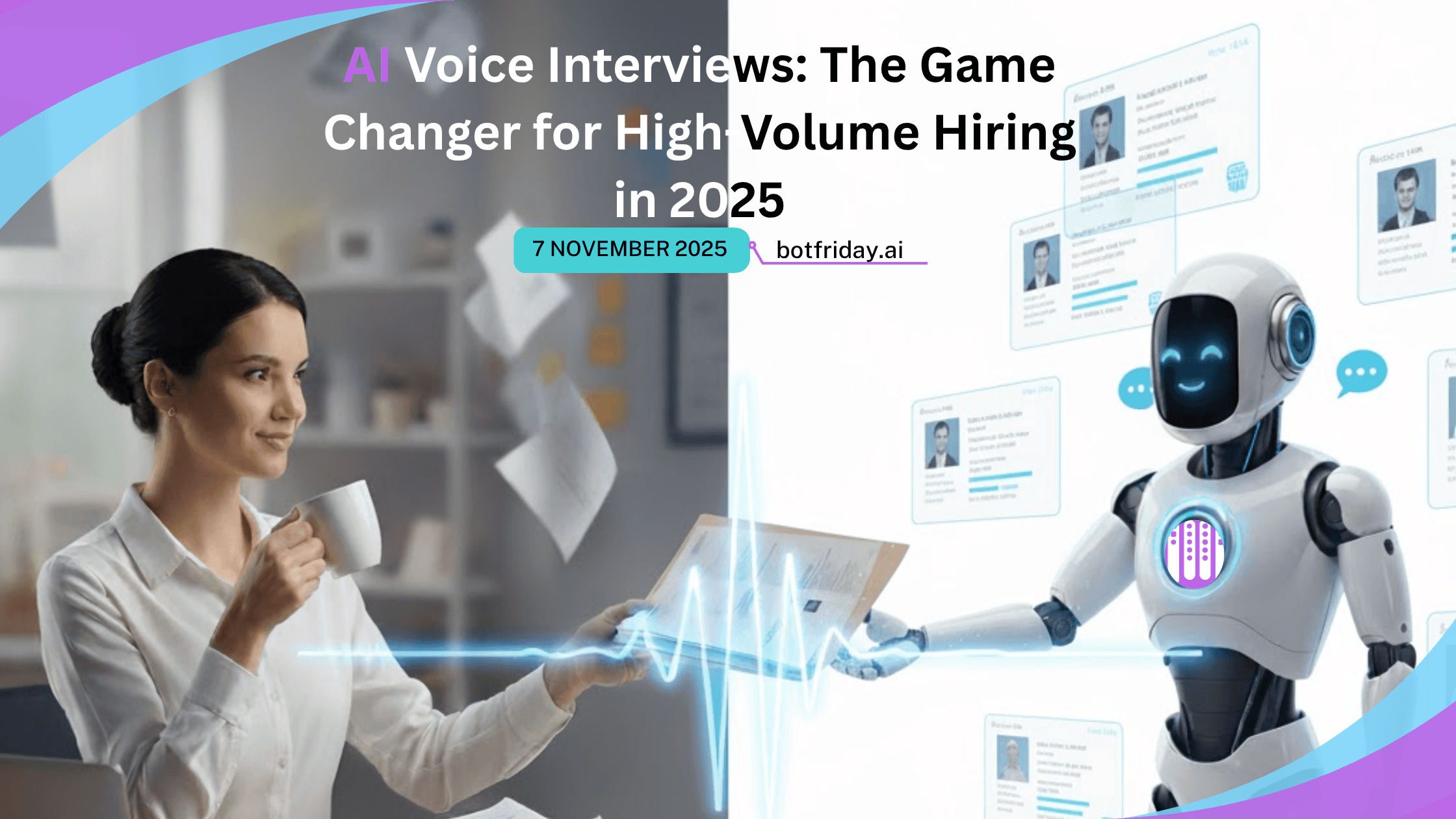How AI Could Transform Your Hiring Speed: A Realistic Look at Modern Recruitment
7
min read
September 24, 2025
If you're hiring right now, you already know the pressure.
One urgent role can fill your inbox with 300+ resumes. Now imagine needing to hire 50 people in two weeks, without slowing down your team or compromising on quality.
It’s overwhelming. And yet, that’s the reality for fast-growing companies today.
The old recruitment playbook, manual resume reviews, endless screening calls, and inconsistent shortlists, just doesn’t hold up anymore. You’re not alone if it feels like you’re spending all day in hiring sprints and still falling behind.
But here’s the good news: AI can take a huge load off your plate, especially when it comes to high-volume hiring.
In this blog, I’ll walk you through what modern recruitment automation actually looks like, where AI fits in, and how it can transform your hiring speed without sacrificing quality. No fluff, just a clear, realistic look at what’s possible today.
Let’s start where most hiring bottlenecks begin: screening.
Where Traditional Hiring Breaks Down
Most hiring teams follow a familiar path:
Post the job
Wait for applications
Manually screen resumes
Schedule phone screens
Conduct interviews
Repeat
This might work when you're hiring for one role. But once you’re handling multiple roles—or hiring at scale, things break fast.
Here’s what that breakdown really looks like:
Manual Resume Screening
Each resume takes 5–10 minutes to review. For 300 applicants, that’s 25–50 hours of work just to shortlist. Screening becomes guesswork, especially when under pressure to move fast.
Scheduling Chaos
Even before interviews begin, calendar coordination eats up hours. Multiply that by 50+ candidates and multiple rounds, and your hiring team becomes a booking agency instead of a strategic partner.
Inconsistent Evaluations
Different reviewers. Different criteria. No standardized scoring. Qualified candidates slip through the cracks, and hiring becomes biased, reactive, or both.
Delayed and Disconnected Communication
From ghosted follow-ups to confusing updates, candidate experience suffers. Top talent moves on while they wait. HR inboxes pile up with follow-ups, missed reminders, and misplaced notes.
Siloed Tools and Spreadsheets
Recruiters use email, hiring managers use Slack, interviewers scribble on paper. Without a central source of truth, critical information gets lost, and your process becomes untrackable.
No Visibility Into What’s Working
Which job board delivered the best applicants? Why did candidate quality drop this week? Traditional processes offer no data-backed insights. Hiring decisions happen in the dark.
Scalability Stops at 3 Roles
Hiring for one role? Manageable. Five roles? Chaos. Once volume increases, traditional workflows can’t keep up. Speed drops. Quality drops. Team morale drops.
How AI Recruitment Tools Actually Work
Modern AI recruitment tool, such as BotFriday AI address these bottlenecks by automating time-intensive tasks while maintaining (and often improving) consistency in candidate evaluation.
Automated Resume Screening
Instead of manually reading each resume, AI systems:
Extract key information (skills, experience, education) automatically
Compare candidates against specific job requirements
Score or rank candidates based on how well they match criteria
Flag potential concerns or missing qualifications
What this means practically: A hiring manager receives a ranked list of candidates with explanations for each ranking, rather than spending hours reading individual resumes.
Intelligent Interview Scheduling
AI-powered systems can:
Send interview invitations automatically to qualified candidates
Handle auto scheduling through calendar integration
Conduct preliminary assessments through customised questions
Route qualified candidates to human reviewers
Real benefit: Reduces the administrative burden of coordinating multiple interview schedules while ensuring qualified candidates move through the process quickly.
Consistent Evaluation Criteria
AI systems evaluate every candidate using the same criteria, which helps:
Eliminate human bias in initial screening
Ensure consistent standards across all applications
Document reasons for decisions (important for compliance)
Identify candidates who might be overlooked in manual review
Realistic Benefits You Can Expect
Based on real-world user feedback and industry research, here’s what companies typically gain by switching to a platform like BotFriday.ai:
1. Cut Screening Time from Hours to Minutes
Old way: Manually review resumes for 5–10 minutes each.
With BotFriday: Bulk process hundreds of resumes in under 10 minutes, with ranked results and AI-backed scoring.
Hiring teams save 20–30+ hours per role and get to serious candidates faster.
2. Faster Candidate Engagement (No More Delays)
BotFriday automates:
Acknowledgment emails
Interview scheduling
Reminders and status updates
No more ghosting. Qualified candidates stay warm, and your team stays ahead.
3. Consistent, Bias-Resistant Decision Making
BotFriday uses custom AI filters and scoring logic, so every candidate is evaluated against the same criteria, even if they apply at 2 a.m. or during a hiring manager’s busiest week.
4. Complete Screening Transparency
With BotFriday’s decision log, you get:
Clear reasons why a candidate was accepted or rejected
A transparent audit trail for compliance
Tools to improve your hiring criteria over time
Whether you’re onboarding a new recruiter or reviewing hiring trends, this documentation is gold.
5. Intelligent Red Flag Detection
BotFriday automatically flags:
Employment gaps
Irrelevant experience
Missing qualifications
This lets you catch problems early, before wasting interview slots.
6. Built-in Scheduling + Voice Interview Automation
Unlike most tools, BotFriday doesn’t stop at shortlisting.
It offers:
Automated scheduling
AI-powered phone interviews with Agent Vox
Interview score summaries based on voice data
This means your team interviews 24/7, even when no one's online.
7. Better Candidate Experience at Scale
From fast updates to clear rejections, BotFriday treats every candidate professionally, even at high volumes. You’ll build a stronger employer brand, reduce drop-offs, and keep top talent interested.
Choosing the Right Approach
Not every company needs the same level of AI automation:
High-Volume, Standardized Roles: Customer service, sales associates, and similar positions often work well with extensive AI automation.
Specialized Technical Roles: Engineering, design, and other specialized positions may benefit from AI screening but require more human evaluation.
Senior Leadership Roles: Executive and strategic positions typically need minimal AI involvement, with human judgment driving most decisions.
Mixed Hiring Needs: Many companies use AI heavily for some roles while maintaining traditional processes for others.
The Realistic Future of AI Hiring
AI recruitment tools are becoming more sophisticated, but they work best as assistants to human judgment rather than replacements. According to Deloitte's research on AI in HR, the most successful implementations combine AI efficiency for routine tasks with human insight for complex decisions.
Companies that approach AI recruitment with realistic expectations and proper implementation typically see meaningful improvements in hiring speed and consistency. Those that expect AI to solve all hiring challenges or implement systems without proper setup often struggle.
The key is understanding where AI adds value to your specific hiring process and implementing it thoughtfully rather than rushing to automate everything at once.
Final Thoughts
The potential for dramatic recruitment improvements through AI is real, but success requires realistic expectations and thoughtful implementation. Companies that achieve the best results start small, measure carefully, and expand gradually as they build expertise.
BotFriday's AI dual-agent approach represents the kind of specialized technology that can deliver both speed and quality improvements. However, the technology alone isn't enough. Organizations need clear processes, defined criteria, and teams willing to adapt.
The competitive landscape is shifting. Companies still using entirely manual processes may find themselves at a disadvantage as AI-powered competitors respond faster to opportunities and scale more effectively.
For organizations considering this transition, start with realistic pilots, measure objectively, and scale thoughtfully. The goal isn't replacing human judgment but augmenting it with intelligent automation for routine tasks.
The 85% time reduction scenario isn't just possible. For companies that implement AI recruitment strategically, it may soon become the standard rather than an ambitious goal.
Key Takeaways
1. What types of companies see the most significant benefits from AI recruitment automation?
Organizations with high-volume hiring needs typically see the most dramatic improvements. This includes call centers, customer service operations, sales teams, and rapidly growing startups. Companies that hire for standardized roles with precise requirements tend to achieve better results than those that hire for highly specialized or senior positions.
2. How accurate are AI recruitment tools compared to human screeners?
Industry studies suggest well-configured AI systems can match or exceed human accuracy in initial screening stages, particularly for high-volume roles. The key advantage is consistency - AI doesn't have bad days or unconscious biases. However, human judgment remains valuable for complex roles and final hiring decisions.
3. What should companies expect during the first few months of implementation?
Most organizations see initial results within 4-6 weeks, but complete optimization typically takes 2-3 months. Early phases focus on system configuration, testing accuracy, and training teams. Companies often start with one role or department before expanding to other areas of the business.
4. How do candidates typically respond to AI-powered recruitment processes?
Candidate reactions vary by generation and industry, but faster response times and consistent communication generally lead to improved satisfaction. Many job seekers appreciate receiving quick feedback rather than waiting weeks for a response. The key is transparency about the process and maintaining human touchpoints for final interviews and essential communications.
5. What ongoing maintenance do AI recruitment platforms require?
These systems need regular monitoring and adjustment based on hiring outcomes. This includes updating job criteria, reviewing AI recommendations for accuracy, and refining interview questions to ensure optimal performance. Most platforms provide analytics to help optimize performance, but companies should plan for ongoing management rather than a "set it and forget it" approach.




